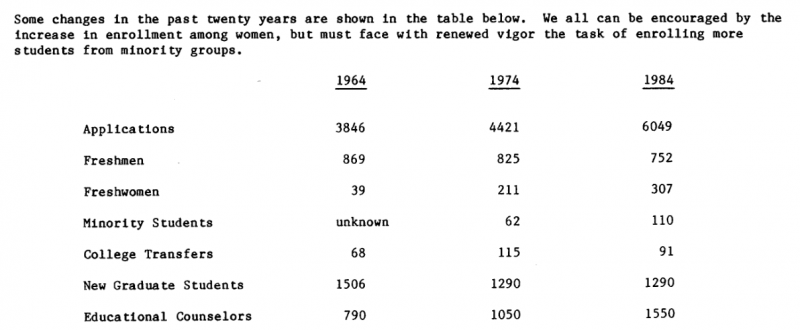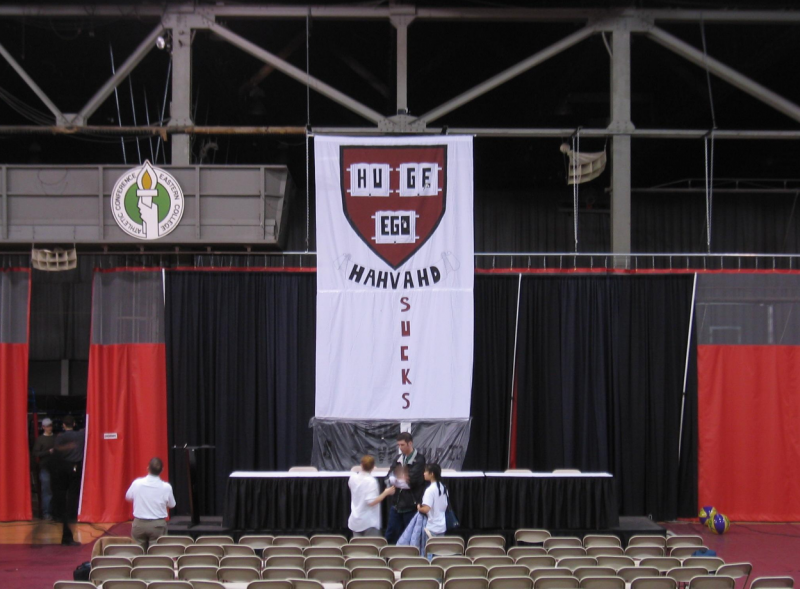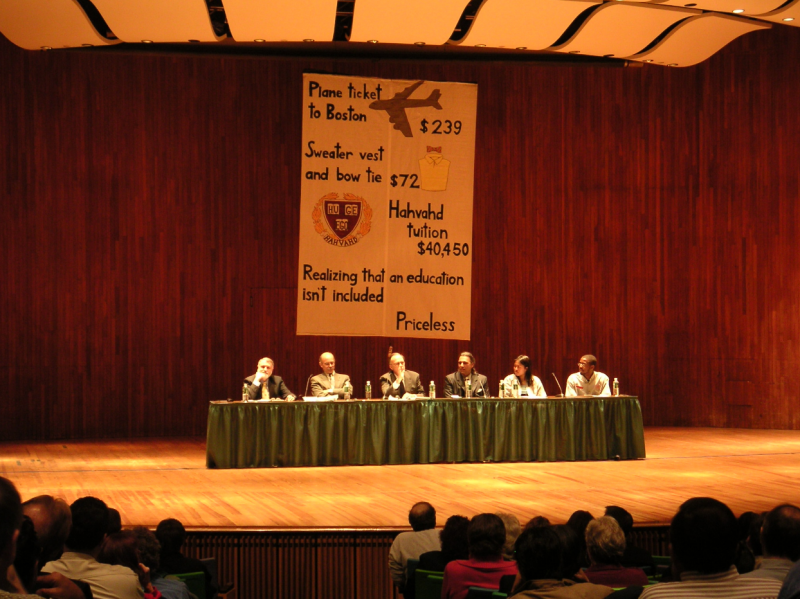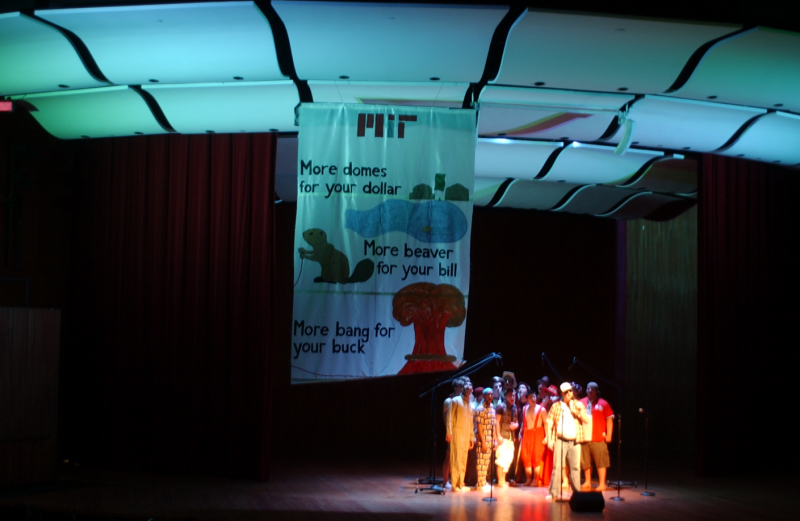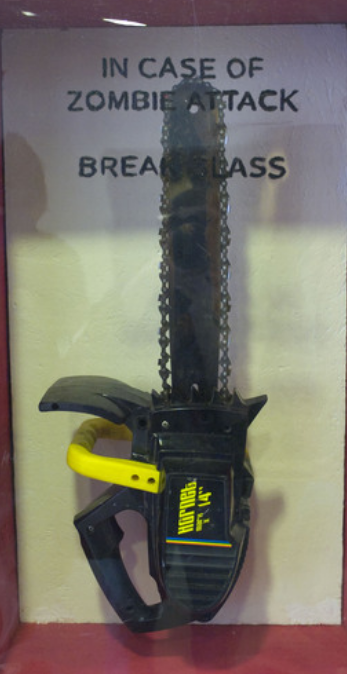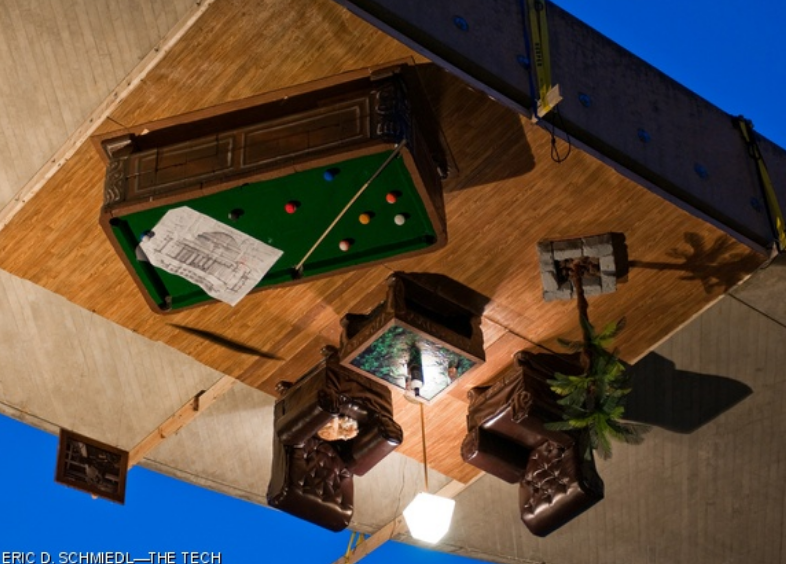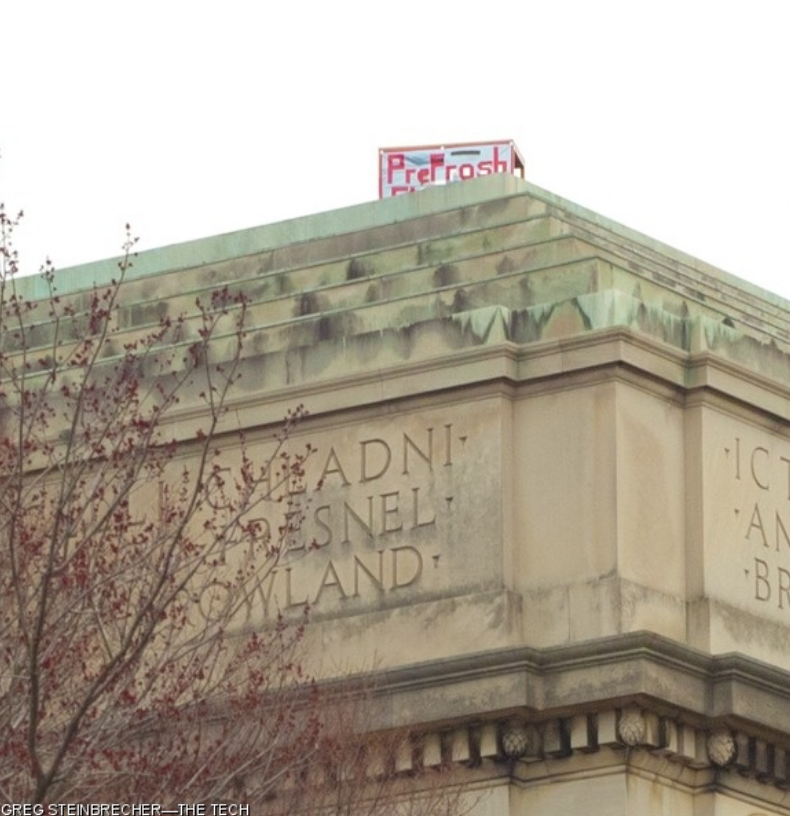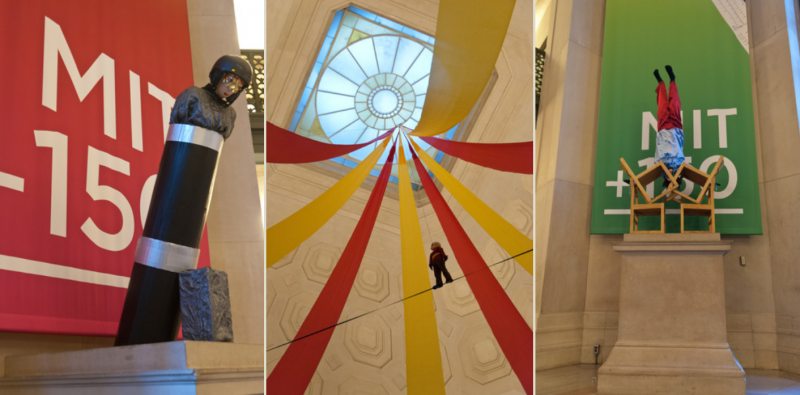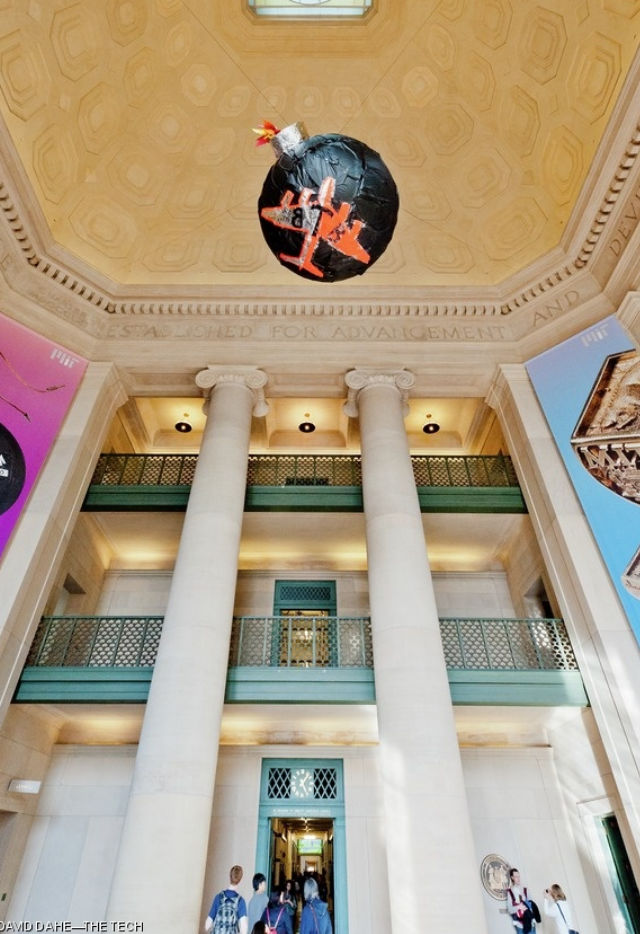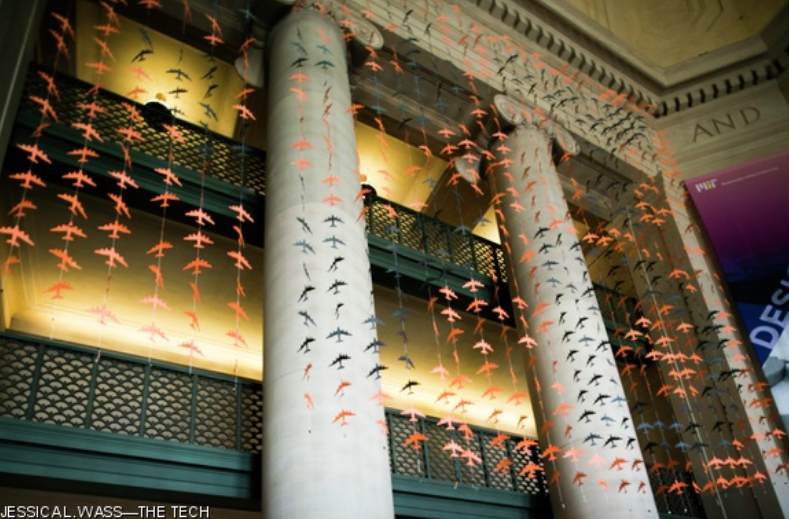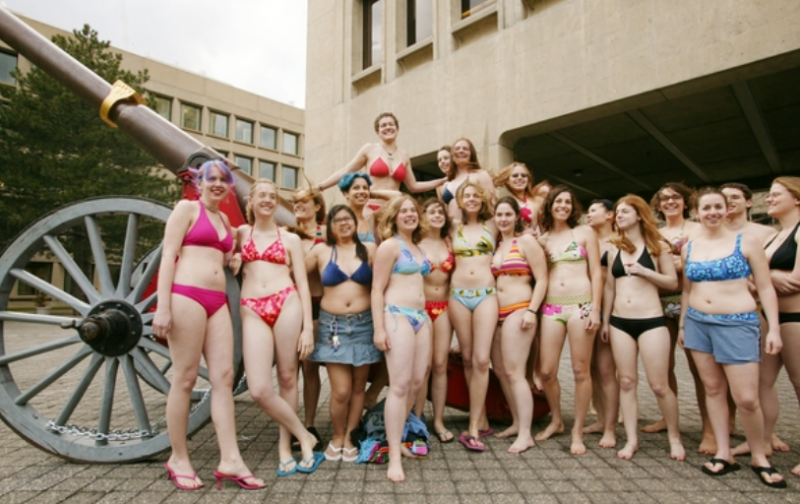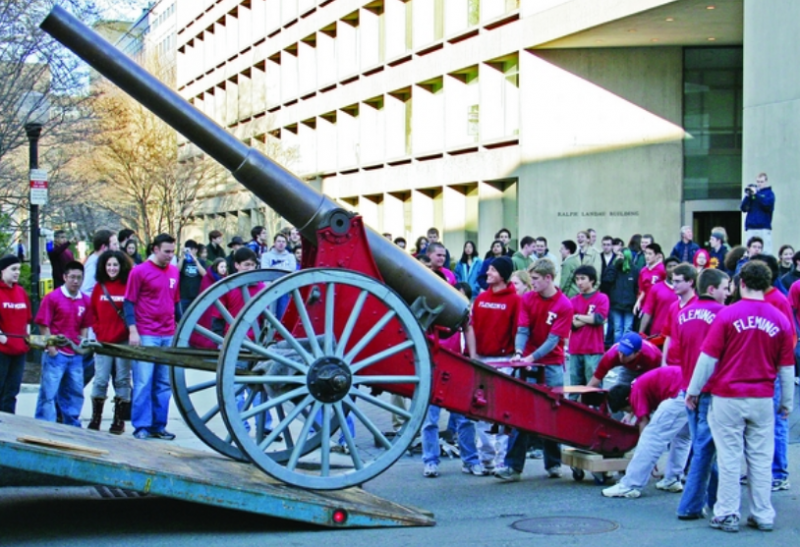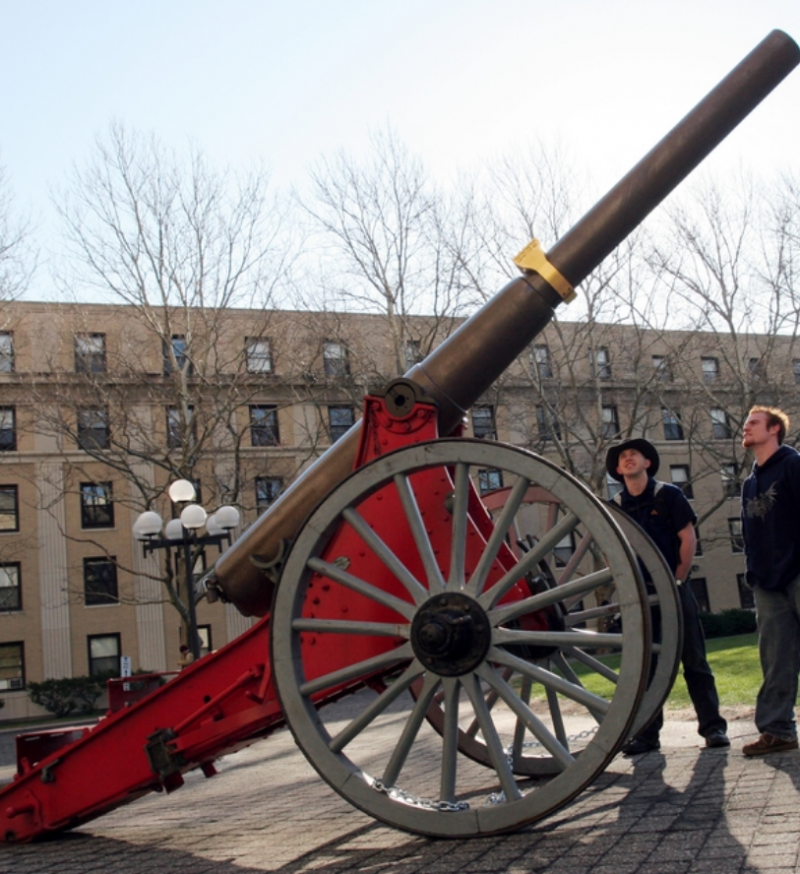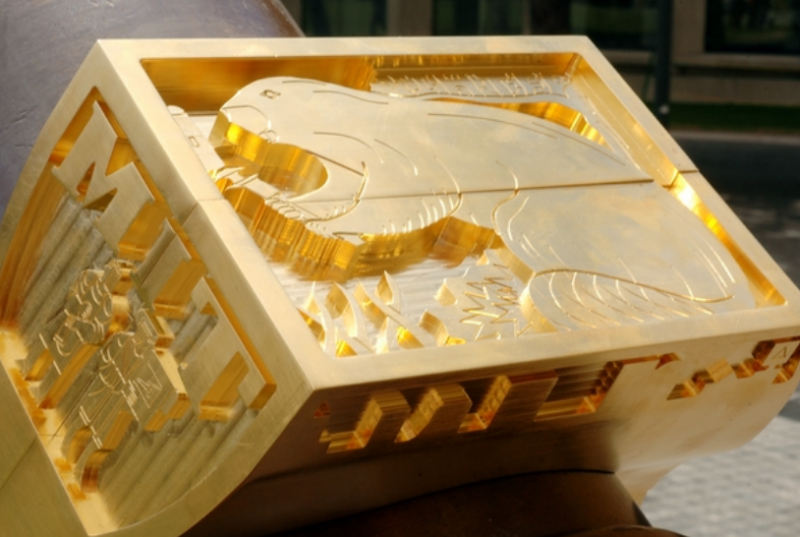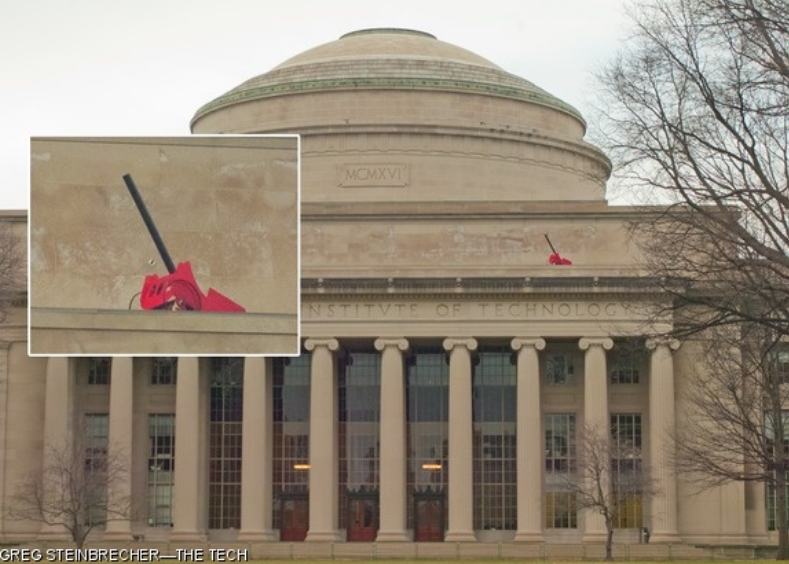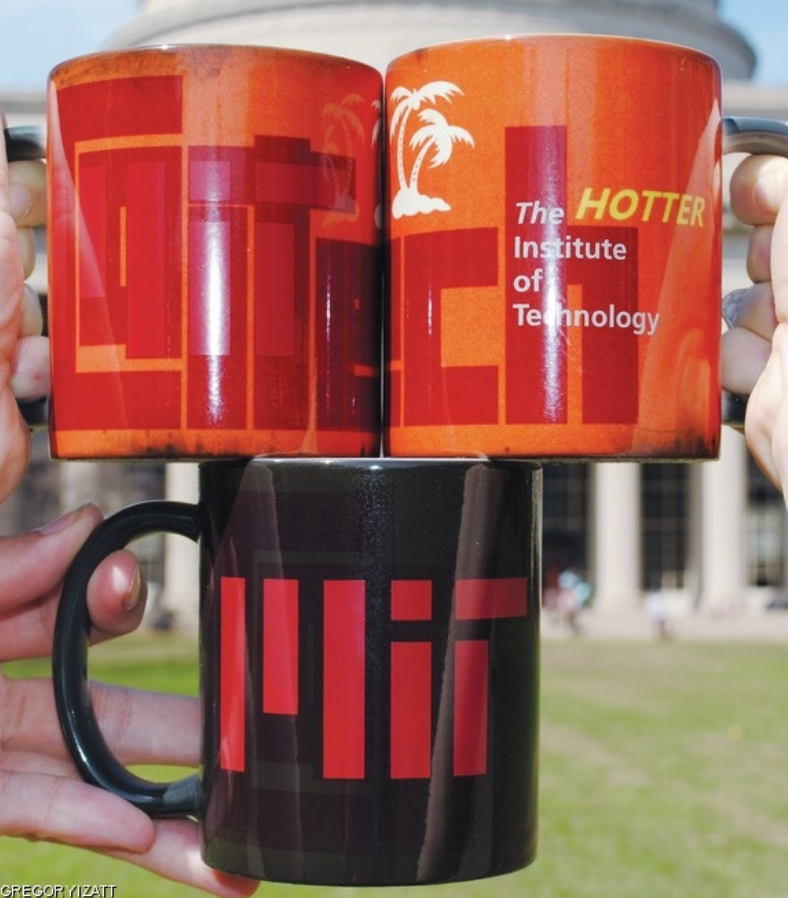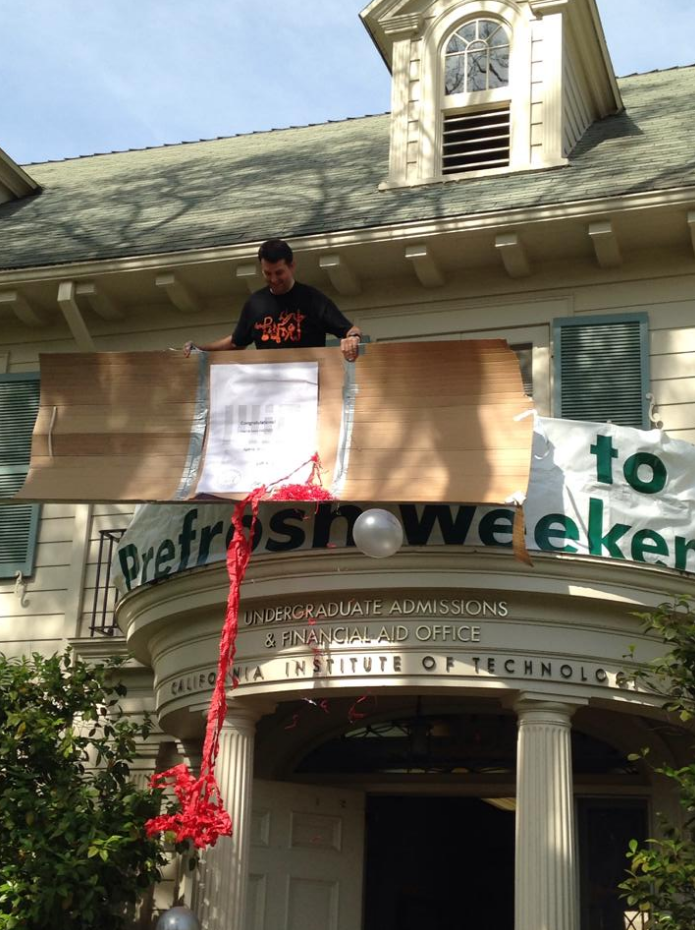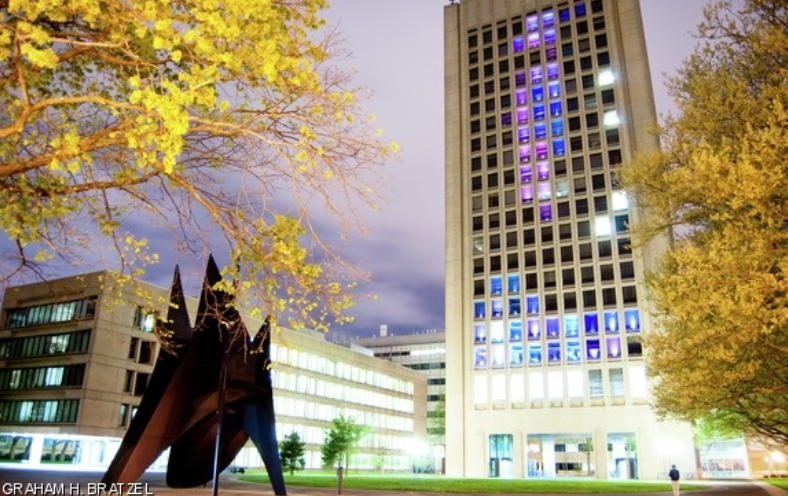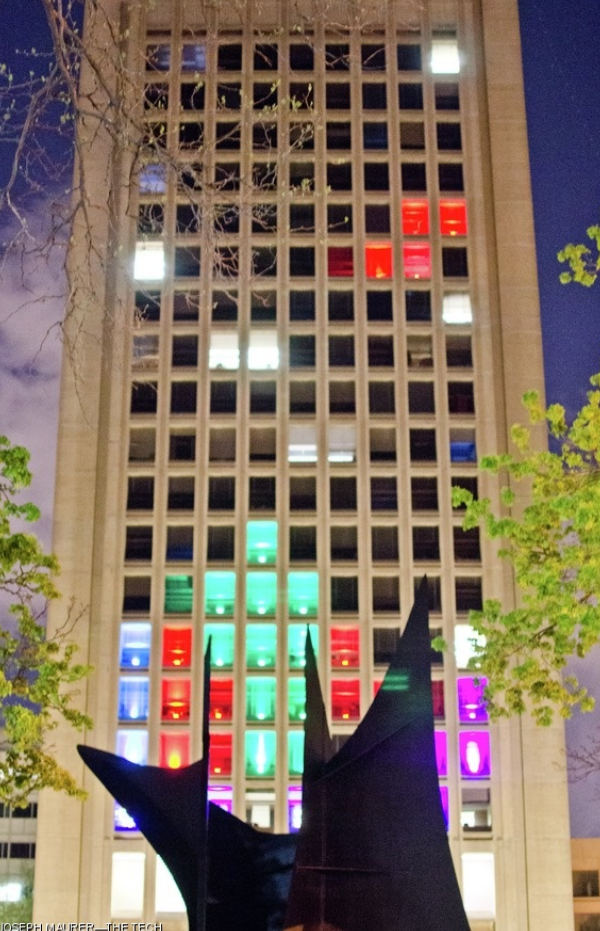
The rise and fall of CPW by CJ Q. '23
all the cpw history, plus proof the weather machine is fake
I’ve been busy recently because of CPW. Like last year, CPW is being held virtually this year, and there’s a large CPW Discord server where people sent lots of messages.
Trinidad, one of the admissions directors, sent a message asking about historical CPW weather patterns. Petey tagged me. I tried to resist the temptation to actually look into this, knowing I’d be going down another history research rabbit hole.

complaints about light mode will not be tolerated
Unfortunately, I was weak of will. It started innocently enough—trying to figure out when and how CPW started by reading old issues of The Tech, MIT’s student paper. Soon enough, I found myself looking at dozens of issues over dozens of years, digging through the MIT Reports to the President, and I even ended up interviewing Matt McGann. You know, the admissions officer who made the second post on the blogs, seventeen years ago.
So here’s the history that I put together—a story that starts in the 1980s and ends today. There’ll be actual citations, some synthesizing, and rampant speculation on my part; I’ll make sure to note which is which. We’ll continue the convention of “now” referring to the time period discussed, and “today” referring to the present. And yes, we are going to talk about weather.
Before CPW was CPW
The first weekend
CPW’s origins are rooted in a program for prospective women and minority first-year students. There was an ongoing effort to increase enrollment among women and minorities through 80s, and rightly so—very few women and minority students entered the first-year classes.
As Director of Admissions Richardson wrote in the 1984 Report, “the character of MIT’s student body is dictated by who applies and who decides to enroll. In other words, self-selection controls our future and the admissions process.” So there are generally two kinds of recruitment efforts: those that get more people to apply, and those that get more people to enroll.
For example, the Admissions Office would match admitted students to current students for overnight stays over a weekend. They’d post a list of admitted students outside their office, and then hope that current students would contact admitted students from their hometowns.
But there were also more targeted efforts. This 1981 issue and this 1982 issue of the Tech describe how admissions had telethons, where women MIT students contacted admitted women students. Such efforts were necessary, because at the time, a smaller proportion of admitted women than men chose to attend.
For minority students, the 1981 issue describes a similar telethon, while the 1982 issue talks about the earliest thing I’ve seen in the Tech that could be considered an admitted student weekend. This minority student weekend wasn’t a very large program: 182 students were invited, and 38 participated. One attendee was even quoted saying that the events are similar to those held at other universities. So admitted student events were already things then, although they were probably much smaller, and probably consisted of mostly panels and presentations.
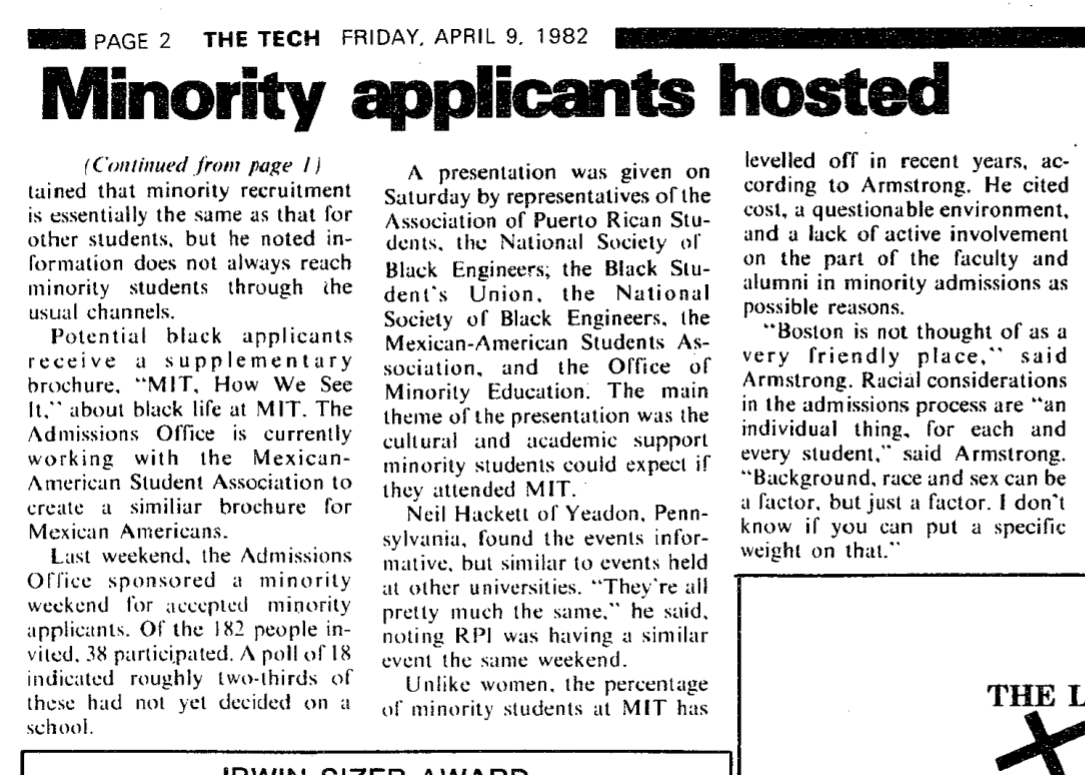
from the tech
My guess is that this was something of a predecessor to the larger Women’s Weekend held two years later, in 1984. In an interview, McGann said that the program was conceived by Marilee Jones, then an Associate Director of Admissions. This weekend was the topic of a Tech column, “Bring more women to MIT”.01 I have read this column twice and I still don't get it. The author muses, “Supposedly, the more these accepted women know about MIT, the greater the chance they will come here this fall, since MIT really is the best school in the world once you get to know us.”
Well, it’s true. Or at least, going to the Weekend was correlated with enrolling. One of the important statistics in admissions is the yield, which is the percentage of admitted students who actually end up enrolling. For the class admitted in 1984, 57% of them ended up committing.02 Per the 1986 Report, 1059 out of 1854. But among the students who went to Women’s Weekend, the yield was 75%.03 See <a href="http://tech.mit.edu/V105/PDF/V105-N14.pdf">this issue</a> of the Tech: 123 enrolled, out of 165 attendees.
It worked, so do it again
In 1985, there were now two programs. Per this issue, there was Campus Preview on April 8–10 for women admitted students, and a Minority Spring Weekend on April 12–14. Note that April 8–10 is from Monday to Wednesday; in an article, Jones said that this is to encourage students to attend classes and get a feel for MIT.
This Campus Preview, despite sharing two of the words in CPW, was far from the CPW as we know it today. A column published in the Tech that week, “The administration’s shadow lies over MIT’s spontaneity”,04 Incidentally, the same column mentions the recommendation of a committee that parties be shut down at 1 AM, which I think became an Institute-wide event policy in the 90s. criticizes the Campus Preview for not being representative of the fun side of MIT. “There were no lessons on shorting out wall sockets, stealing street signs, arranging friends’ rooms on the Charles River,” writes the author.
So, in 1985, there were two separate programs. There’s no mention of either one anywhere in the Tech in 1986, or in the 1986 Report, except for a single ad thanking people for their participation in “Campus Preview and Minority Spring Weekend”. It’s probably reasonable to assume that there were still two separate programs in 1986.
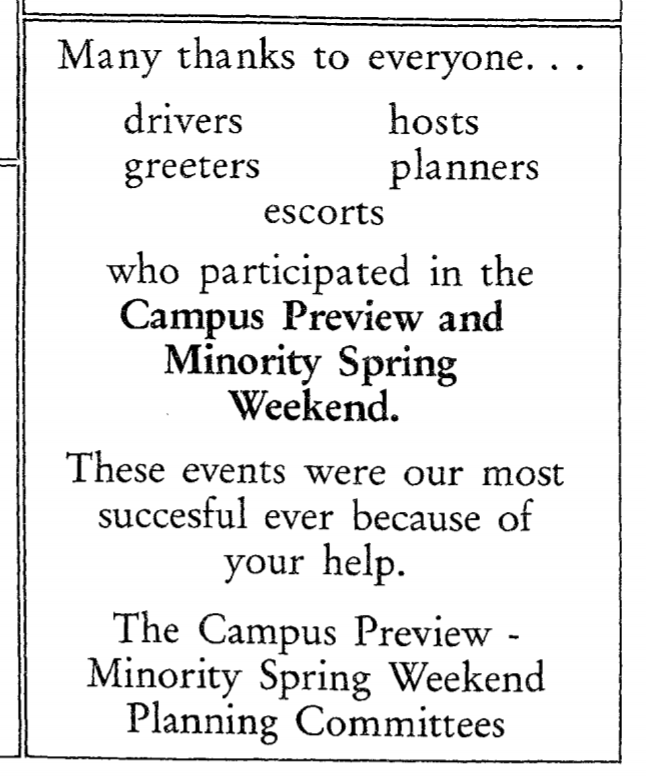
from the tech
By 1987, the two programs were merged to a single Campus Preview weekend. It was held on April 9–11,05 See <a href="http://tech.mit.edu/V107/PDF/V107-N14.pdf">this Tech issue</a>; on the bottom of the second column in the top article. which was Thursday to Saturday that year. That weekend, the Tech had a picture on its front page with people lugging suitcases into what looks like Kresge:
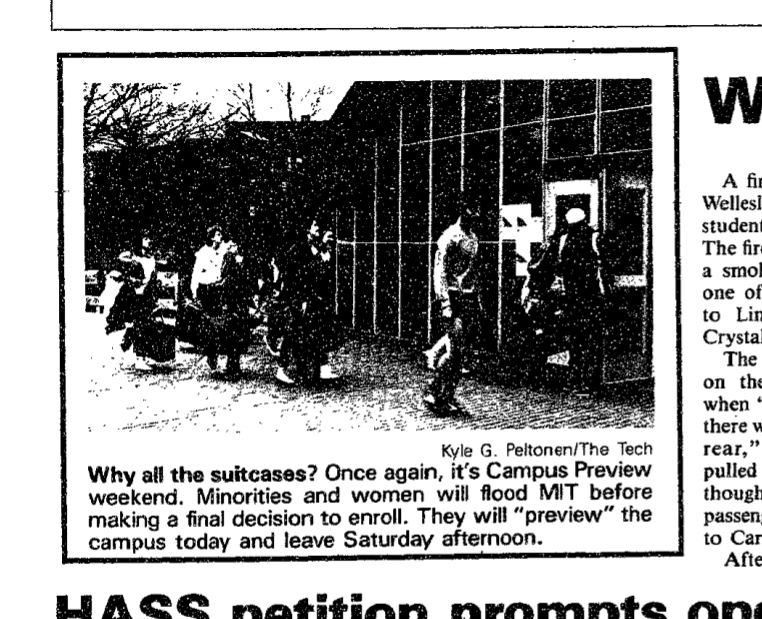
color did not exist yet. from the tech.
Alright. Remember the column I cited from 1985, the one complaining that Campus Preview didn’t show the fun side of MIT? In 1988, there was then a column that complained it was showing students having too much fun (p. 4). The next week, there were two columns (p. 5) that argued otherwise (p. 5). (Content warning for all three columns I just linked: there’s passing mention of suicide.) So interestingly enough, the discussion about whether CPW is a lie isn’t something recent, it’s been around before CPW was even a thing.
We can infer that Campus Preview in 1988 was still far from what we know CPW is like. The third column I cited that Campus Preview “has a few more parties than usual”, and the author described their experience of attending Campus Preview in 1986. “My host pulled an all-nighter the first night[…] She attended class all morning, napped that afternoon, ate supper with me in Lobdell, and took me to a couple of parties that evening.” So Campus Preview was probably still a series of panels, just with more not-sponsored-by-Admissions parties.

from the tech
Slow and steady growth
The next few years of Campus Previews didn’t leave much documentation, at least not in the places I looked at. Only passing mentions in the Reports to the President. The Tech had some sort of “welcome prospective freshmen” message on top of its issues during Campus Preview from 1989 to 1991, but no articles.
There’s a single article from 1992. It mentions 258 attendees, which is the next number we’ve gotten since our previous number of 165 attendees for Women’s Weekend in 1984. This gives us a better picture of what the weekend was like, so I’m going to quote it wholesale:
The weekend included many organized activities, including welcome receptions, tours of athletic facilities and UROP labs, and a discussion on financial aid[…]
There were also several social events, such as the African American/Native American and Mexican American/Puerto Rican extravaganzas, an ice cream orgy with Hard Rock Cafe volunteers serving the prospective freshmen, a performance by an MIT dance group, and the check-out barbecue on Saturday. “It went off successfully, but there weren’t enough people who showed up,” said Shawniqua T. Williams ’94, a student coordinator.
In addition, many campus activities held special events, and some living groups also held parties during this weekend. Gonzalez expressed disappointment that these parties were focused on the 224 women that were only a part of a weekend designed for minorities as well women.
It looks like there were a handful of official activities, for which the turnout was low. So most of the things prefrosh did were random unscheduled things, I guess? There’s also about 50% more volunteers than were needed, so undergraduates were very interested in helping out.
None of the articles from 1993 to 1995 were directly about Campus Preview, but there are several articles that mention it. Of those that do, the style’s inconsistent between calling it “Campus Preview weekend”, with a lowercase W, and “Campus Preview Weekend”, with an uppercase W, although none of them call it “CPW”. My general impression from these articles is that, while the program was successful in increasing yield06 See <a href="http://tech.mit.edu/V114/N30/women.30n.html">this from 1994</a> and <a href="http://tech.mit.edu/V114/N68/women.00n.html">this from 1995</a>. among women applicants, that yield was plateauing.07 See <a href="http://tech.mit.edu/V113/N15/1997.15n.html">this from 1993</a> and the yield among minorities <a href="http://tech.mit.edu/V115/N30/admittees.30n.html">this from 1995</a>
There was also this article about Sigma Alpha Epsilon, a frat, taking a prefrosh by mistake, but there was never a follow-up to it. Remember the frat’s name, SAE, it’ll come up again later.
The years 1996 to 1998 saw increased discussion and larger attendance to Campus Preview Weekend. The last number we saw for attendees was 258 in 1992; by 1996, there were 425 attendees. It dipped to 360 in 1997, and then back up to 415 in 1998. I also don’t know where to fit this in, but there was already an admissions website back in 1996. Look at those pictures of bullets!
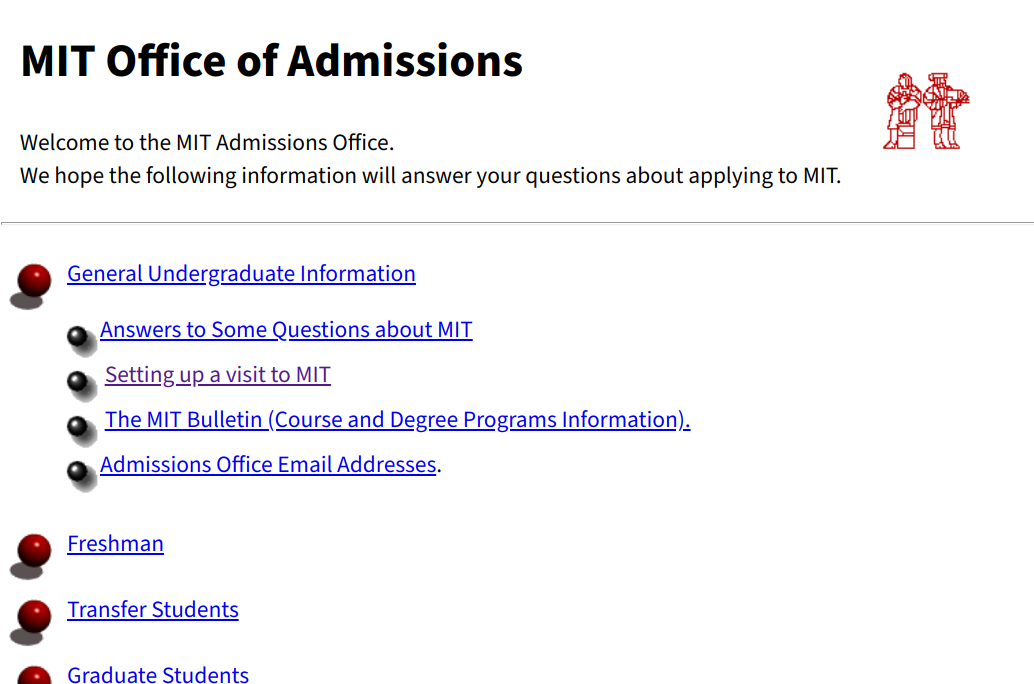
love that web 1.0 design
Two articles both from 1997, in particular, provide a good picture of what its Campus Preview Weekend was like. On Thursday evening, there was a panel for prefrosh to ask questions of current students, followed by a jazz social and dinner at Walker, with music from the MIT Jazz Collective. On Friday, there were several UROP tours, some guest lectures, then another dinner at Walker with another guest lecture. Then there was the check-out lunch on Saturday. This weekend seemed to be more popular with the students, with quotes like “I’ve been to four other college preview weekends, and this one was the best” or “I was surprised at how friendly people were.”
Note the lack of focus on residences, activities, or departments. The article mentions that several departments and labs had open houses, and student-organized discussions from women and minority students. There were probably unofficial parties from living groups, but that’s it. This changed in 1998 with an explicit residence fair, for prefrosh to talk to representatives from living groups. This will begin a gradual increase in the number of CPW events that are living-group-related over the next seven years.
Discussion points
Campus Preview Weekend was the focus of two major threads of discussion during this time. The first topic was the role that FSILGs08 Fraternities, Sororities, and Independent Living Groups, the catch-all term for living groups that are neither dormitories nor off-campus housing. Articles at the time used ILGs as a catch-all term for all of them, but today we use FSILGs. had in CPW. So far, prefrosh have been hosted overnight at dorms, the concern being that FSILG members might try to rush prefrosh09 To rush is to recruit. Rush also refers to the period of time in which FSILGs generally recruit people, the biggest rush period being orientation week. if they were hosted there.
Beginning in 1996, some prefrosh stayed in FSILGs instead. The article isn’t entirely clear about this, so for context: Sigma Kappa was a newly formed sorority that MIT was looking for a house for. Because they didn’t have a house yet, they lived in the dormitories, and hence could have hosted prefrosh for CPW. Now, the dormitory Huntington Hall recently closed, leading to some crowding in the dorms. So they temporarily housed Sigma Kappa in Ashdown, which alleviated some amount of crowding, and provided a temporary house for the members while MIT looked for a permanent house. Presumably there were a bunch of members of Sigma Kappa who were hosts for CPW, so admissions just allowed all FSILGs to host prefrosh. FSILG hosts were told, of course, that they were “rushing for MIT and not the house.”
The situation developed a bit next year, in 1997. Prefrosh were asked where they preferred to be hosted, and 80% wanted to live in a dormitory. On the other hand, there were also way more FSILGs that wanted to host prefrosh than there were dormitory residents. So the result was that several prefrosh who wanted to stay in dorms got placed in FSILGs, while several FSILGs who wanted prefrosh didn’t get any.
Now, remember Sigma Alpha Epsilon from earlier? The previous article mentions that SAE complained, during a meeting, that they were assigned way fewer prefrosh than they requested. This was the subject of a column in the next Tech issue, touching once again on the larger concern that FSILGs were using CPW as a rush tool. The author shares his own experience of being hosted in a frat when he was a prefrosh, and describing behavior that was kinda rushing the FSILG rather than MIT in general.
Another column criticizes that CPW provides opportunities for an “over-zealous Greek system” to rush prefrosh. Whether this was an accurate description of the FSILG system at the time is beyond me, but at least some members of SAE were over-zealous in serving alcohol to a prefrosh. This may not sound like a big deal, but believe me, it was. Big enough of a deal that, even today, the no alcohol rule is still a prominent CPW event guideline.
So FSILGs were one of the threads of discussion at the time. The other thread was about the inclusivity of CPW. There was a lot of discussion about whether inviting only women and minorities to CPW was a good thing or a bad thing. Prefrosh themselves had different views, and several columns in the Tech were written about it.
Often this discussion was held in the context of affirmative action, and again, views ranged from dissent to support to “yeah this is a complicated issue” to “no, you all have a wrong idea of what affirmative action really is.” It is absolutely unclear to me how representative these are of the general perception at the time. This is kinda surprising to me, because I thought that the rhetoric around affirmative action only started relatively recently. As an aside, affirmative action’s come up in the blogs again and again and again.
Growing pains
Opening to everyone
Anyway! CPW opened to all admitted students in 1999. Jones, now the Dean of Admissions, hinted at this in interviews the year before, saying the would invite everyone if they could afford to, and that they were hoping the next year would be for all admitted students. It’s unclear how much the discussion I mentioned above influenced this decision. But yield definitely played a part, as suggested by this article. Makes sense, given that at the time, there’s a 70%ish yield among CPW attendees, while the general pool had a 55%ish yield.10 See <a href="http://tech.mit.edu/V118/N16/aprefrosh.16n.html">this article</a>. For reference, the 2024s had a 70%ish yield, given that <a href="https://mitadmissions.org/blogs/entry/mit-regular-action-decisions-now-available-online-3/">1457 were admitted</a> and <a href="https://registrar.mit.edu/statistics-reports/enrollment-statistics-year">there are 1073 first-years</a>. This decision was pretty much confirmed with the release of early action decisions that year. The article states that “women and minority students may be invited to the event a day earlier than other students,” though it wasn’t clear to me whether this actually happened.
Prefrosh could have always scheduled overnight visits to MIT. They would contact the admissions office, and they’d be connected with a current student who would host them for a night or two. Supposedly, this helped prevent crowding problems during CPW. I think it’s reasonable for this to be a concern, given that opening the event to all prefrosh meant that CPW had to scale to about twice its previous size; there were 415 attendees in 1998, and 784 attendees in 1999. An article released shortly before CPW that year reported that there were a low number of male dormitory residents who hosted students, the same problem CPW had had for a few years now.
The Tech issue on the weekend of the CPW is fascinating, and you can read the PDF here. The top headline is an article about CPW with a nice picture of prefrosh walking along Kresge lawn.
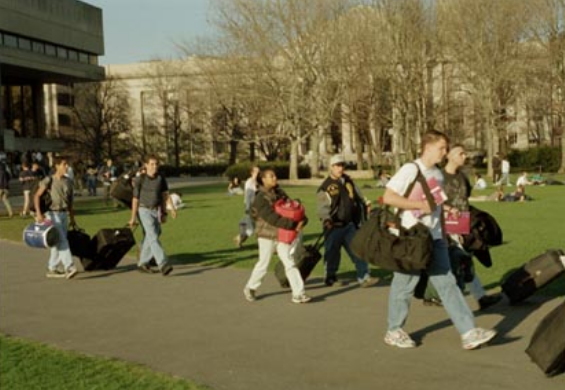
from the tech
The articles in this issue include a report about a protest outside President Vests’s office, with at least two prefrosh attendees, an article about the 1999 orientation mentioning its focus on “class pride”, an editorial criticizing one of the CPW events, and a column about the author’s experience attending CPW the last year.
All interesting reads. I’d like to highlight the column specifically. The author talks about how she really liked her host and the floor she stayed in, and ended up living in the same floor. I think this only goes to show how important the residential experience was during CPW. The same author, by the way, wrote another column about their CPW experience this year in next week’s Tech issue, which I also think is a really good read.
Another interesting thing about this issue is how a lot of the events and advertisements were aimed at prefrosh. The LSC,11 The Lecture Series Committee, which has nothing to do with lectures, series, or committees, and instead is a club that shows movies. for example, had a bunch of movies in 26-100 listed as “free for prefrosh.” There’s Patrol, one of my favorite Assassins’ Guild events, which I’m glad to see has existed since at least 1999. There’s also “Mega Band Party Plus, featuring Actual Proof. Live Funk Music. Free Food. Prefrosh Welcome. Baker Commons.”
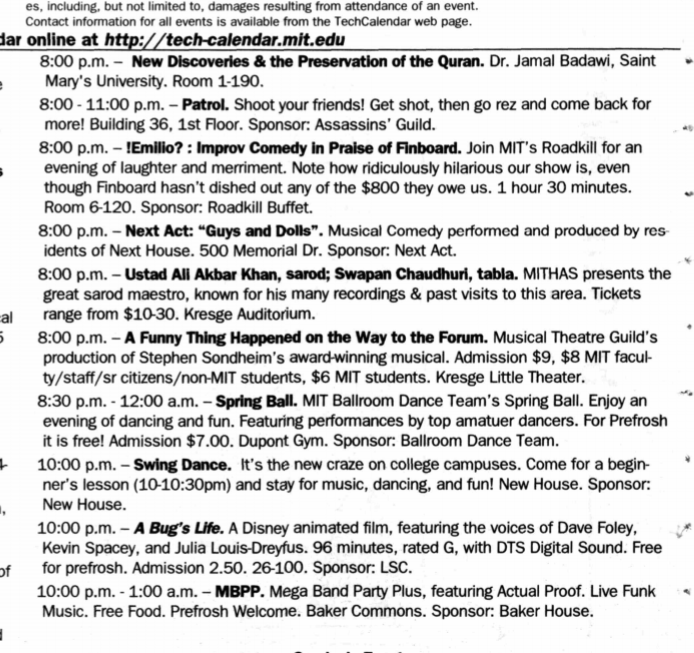
look, there’s patrol! and also things from lsc. and also mbpp? from the tech.
There’s an ad from the Tech, prominently taking up half the back page, advertising free dinner and Tosci’s ice cream.

a 61″ tv? do they still have that? from the tech
There’s an entire, full-page ad from the IFC,12 The Interfraternity Council, which is, well, a council of the fraternities of MIT. formatted to look like a news page. Lots of interesting things in this page that we’ll talk about more shortly.
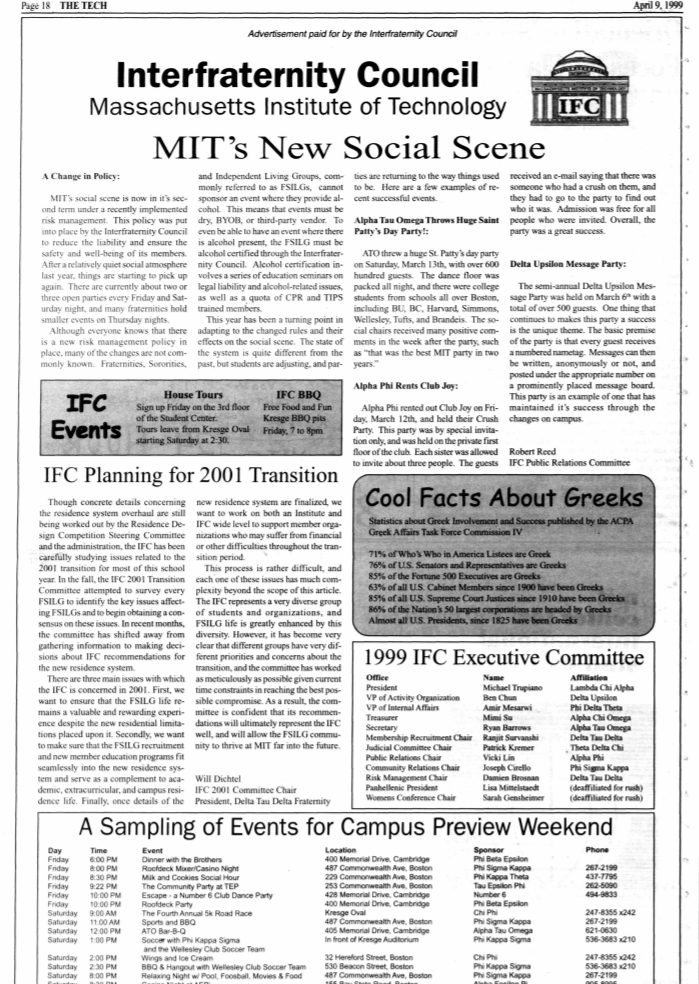
yes, this is an ad. from the tech
Also not sure where to put this, but I’d like to point out that there’s also a review for The Matrix in this issue of the Tech. The Matrix, you know, the movie, came out the week before CPW 1999. Interesting times.
An article that appeared in the next issue has some quotes from current students, all agreeing that they prefer Campus Preview Weekend over “Women and Minorities Weekend”. I’m not quite sure where the phrase “Women and Minorities Weekend” comes from. The event has previously been referred to as “Campus Preview” or “Campus Preview and Minority Spring Weekend”, so my guess is that the phrase is a post hoc name invented after this year’s CPW.
The 1999 CPW seemed pretty successful, in terms of increasing yield, giving an overall 60% yield that year, a big increase compared to 55% yield in the previous years. The article reports that 73% of those who attended CPW committed, as compared to 67% the previous year, although I won’t think too hard as to whether it’s causation or just correlation.
First-years and FSILGs
Of course, not everything was smooth sailing. Remember that full-page ad the IFC took out on the Tech during CPW? Some people thought that it was rather excessive. I mean, sure, it’s double the size of the Tech’s huge ad on the back of the paper. But, according to one columnist, this full-page ad was only one of IFC’s several excesses in making CPW more rush-like than it should’ve been.
The author criticized FSILGs to be “MIT’s willing accomplices” in “trying to impress prefrosh”. He cites a party he went to during CPW that neither he nor his friend enjoyed, implying that the party was aimed solely at the enjoyment of prefrosh. Supposedly, the Tech also didn’t allow IFC to publish propaganda as a news article, which explains why the format of their ad. In a letter to the editor, the IFC clarified that this was not the intent, and defended IFC’s efforts during CPW as promoting “camaraderie and fun”.
On the other hand, the Tech published an article that fall that quoted several first-years, saying that CPW was helpful in learning about residences. So whether or not the events were for camaraderie and fun, they definitely swayed prefrosh towards one living group or another. Which brings me to the main question I want to discuss: why were FSILGs so active in promoting themselves during that CPW?
First of all, it’s not as if the FSILGs were unusually active. Rush at MIT had always been a big deal; remember that “over-zealous Greek system” quote? While the Tech usually published on Tuesdays and Fridays, during R/O,13 Residence and Orientation Week. the Tech published daily issues. The highlight of these issues would be “The Daily Confusion”, a huge listing of all the events happening that day. In 1999, there were five whole pages of Daily Confusion. And that was only for the first day of rush.
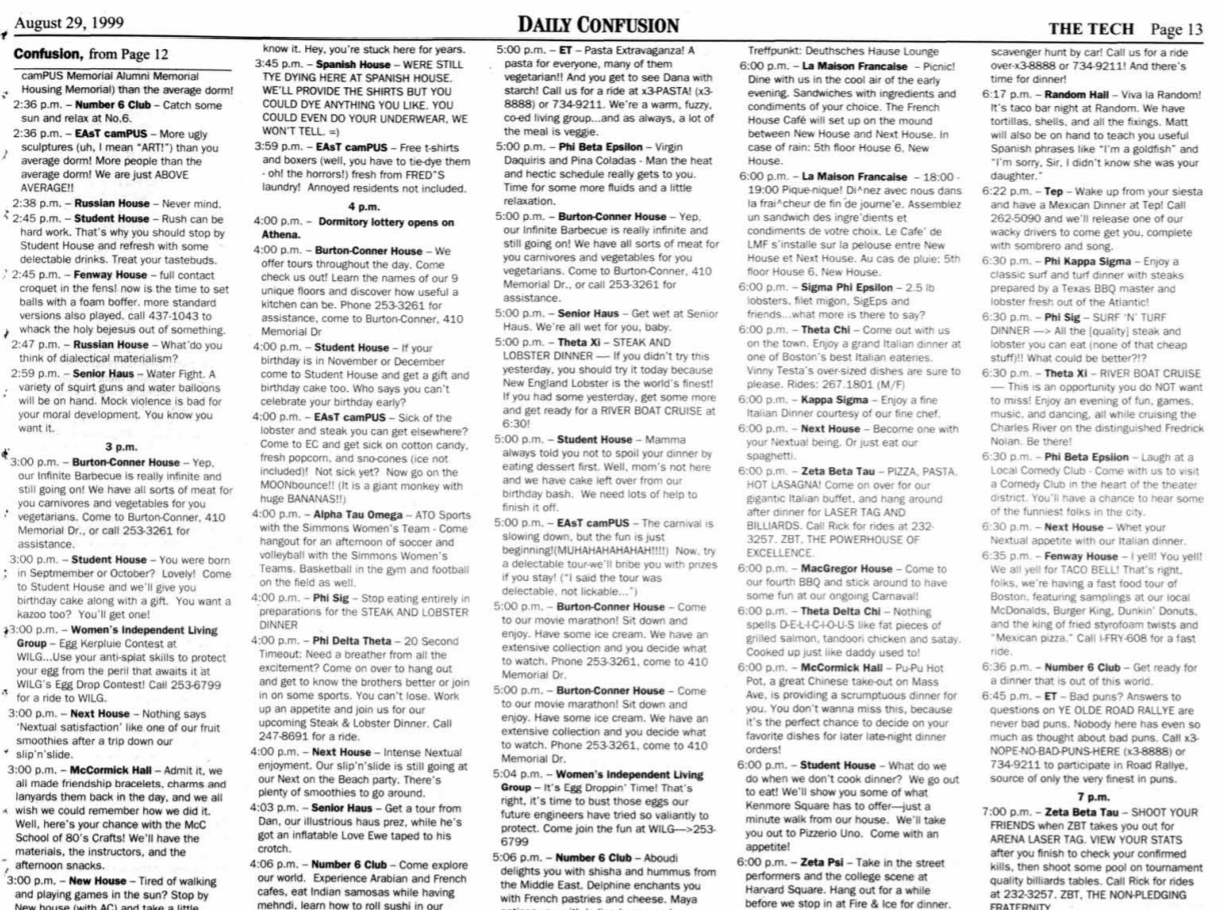
there are FIVE PAGES of this. from the tech
So FSILGs doing big things for rush isn’t unusual; it’s part of what they normally do. I want to point out that it’s unusual for them to do rush during spring. And I’m speculating14 Hat tip to McGann for pointing this out to me during our interview. I'm basically building upon the story he told me. that an implicit reason—even though it may not be the direct reason, but it’s definitely something that was on people’s minds—was the so-called 2001 mandate.
The story of the 2001 mandate is a tragic one. I think that, today, many people in MIT know the gist of the story. In 1997, first-year Scott Krueger ’01 died due to alcohol poisoning from a Fiji event.15 Fiji is the nickname for Phi Gamma Delta, a former MIT fraternity. Then the faculty16 Surprising primarily because it's so rare for the faculty to weigh in on student life made a motion to require first-years to live on-campus. The connection to the two isn’t quite apparent; I’m of the impression that a number faculty members have held this view for quite a while now, and the event was the catalyst to get the motion on the floor.
After several revisions, including rejected proposals like a first-year dorm and randomized housing and other nonsense like that, the motion passed. Although it was not binding, the administration generally agreed with it. A new dorm was set to be constructed by 2001, which we know today as Simmons. This would free up enough space to house all first-years on-campus, which was a genuine concern, since 40% of first-years lived in FSILGs at the time.
I’d love to talk more about this, but this is a history of CPW, and not of residences.17 Oh no, will this be a sequel post? Oh please no. The point is that this was a big concern, and was on the top of the minds of students, faculty, parents, and admin. It was discussed in every single Tech issue, in open meetings with the admin, in open meetings with the faculty.
Now, I know how easily gossip can get amplified when there isn’t clear, quick messaging from admin. This was what it felt like to live in the week everything was canceled. I can imagine that if I were a student at the time, hearing all these plans about housing, I could’ve have seen this as an attack on FSILGs, and MIT’s residential system in general. Residents in FSILGs would have bigger reasons to up recruitment: a fear of losing MIT recognition, of the sentiment against FSILGs to spread to incoming students, of not having enough people to maintain the house.
As McGann put it, during our interview:
…students have been deeply committed to these residential communities. So as a way of preserving that and pushing back against all the residential changes that were happening in the late 90s and early 2000s, fraternities stepped up their recruitment, and the dorms stepped up their recruitment to match.
If DTD was gonna have a party every night, EC was gonna have a party every night. It all happened in parallel. The changes in the residential system, the precariousness of the residential system[…] because of those pressures, I think students really stepped up their desire to show the vitality [of the residential system].
Now, I know what you’re thinking. These discussions happened in 1997, and this CPW happened in 1999. Surely half the student body must have dropped the topic after two years. Well, you’d think that, but there was active, lively discussion about this well into 2000, so no, not really. Couldn’t fit enough words in that sentence so here are even more relevant links.
This shouldn’t be surprising, given that MIT students care a lot about the residence system. And why shouldn’t we? Each living group is unique, carrying its own culture and traditions, and the wide variety of cultures means there’s something for everyone. I’d even guess that most undergrads would say that housing is one of the best parts of MIT.
tl;dr: FSILGs pushed hard to recruit during that first CPW because of implicit pressures surrounding planned changes to the FSILG system. This led to dormitories recruiting harder to match, and this is part of the reason why, today, so much of CPW centers on residence exploration.
The growing weekend
Alright, enough speculative history for now. Let’s have a short intermission to talk about how CPW has grown over the years. Here’s a bad graph I made, showing the number of CPW attendees over time:
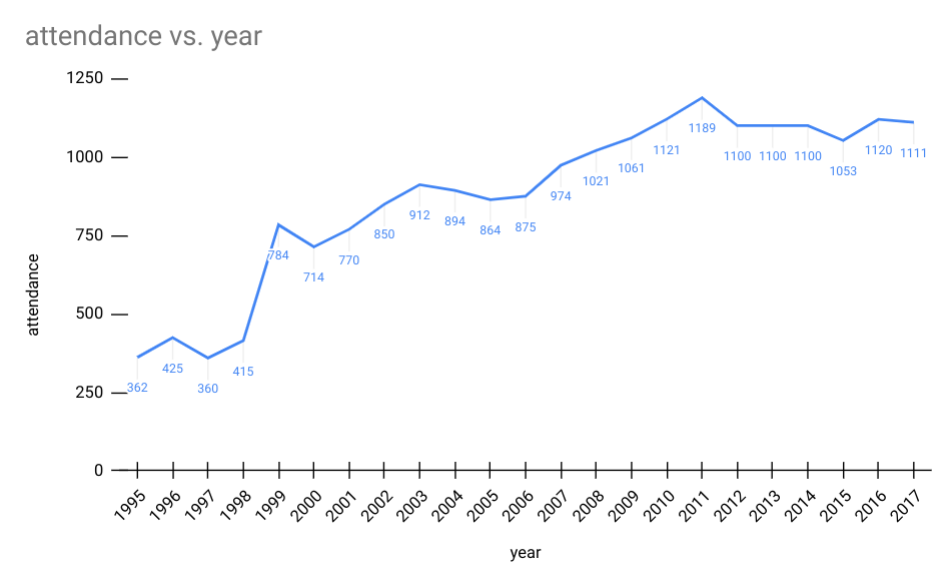
graphs are hard ok
Most of my info was from random articles from the Tech. I actually have numbers for 1984 (165 attendees) and 1992 (258 attendees), but I don’t have numbers for 1993 and 1994, which is why this graph starts at 1995. It also ends at 2018 because I don’t have numbers past that.
Purple wristbands
Here’s a shorter story, after that long digression on FSILGs. This one takes place in 2000.
The Wednesday before CPW, which is literally the day before prefrosh started arriving on campus, Associate Director of Admissions Zaragoza Guerra sent an email to current students, outlining some of the restrictions prefrosh were subject to in CPW. Chief among these was that prefrosh weren’t allowed to go off-campus, except to go to FSILGs, and that they needed to wear purple wristbands all day.
This caused student uproar. Dean Jones met with student leaders on Thursday morning, and announced that the rules would be dropped. It was, of course, a bit too late, as the information packets that were distributed to prefrosh were already prepared. So the packets already had this “very contract-like document” that outlined these rules. Some of the prefrosh had already arrived and signed these agreements when the announcement came out, but students who came later weren’t asked to sign it.
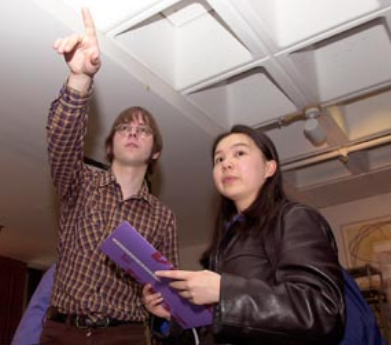
the purple folder is the packet you get when you register for cpw, presumably. from the tech
A column sheds light as to what the letter looked like. It apparently promised “plenty of food“, then talked about wearing purple wristbands at all times, and was signed from dean Jones as “Your Mom Away from Mom”. Jones sent an email later that Thursday defending the overprotectiveness of the “contract”, while also acknowledging that the wristbands were “goony” and that the contract format was “not the MIT way”.
The protest group ILTFP18 A nod to the cry I Hate This Fucking Place, ILTFP stands for I Love This Fucking Place. also wrote a letter to prefrosh. “Cross out any clauses that you’re uncomfortable with[…] Just… don’t do anything stupid.” There was also this “Prefrosh Violation Dinner” advertised in The Tech, which after the announcement was now just a regular dinner and no longer a protest.
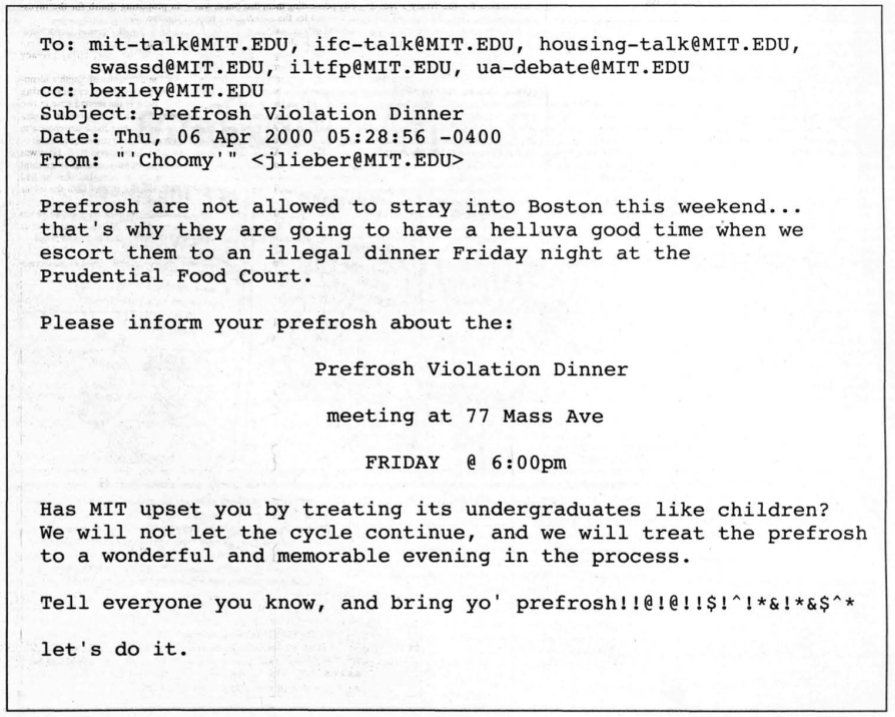
i wonder if [email protected] still exists? probably not. from the tech
McGann, who was a senior at the time, had this to say about it:
People were really upset about the wristbands. In these days you have to walk around your campus wearing your lanyard, so maybe it doesn’t seem like that big of a deal.
One of the worst things that happened, and this was really bad for admissions. There was an admissions officer who, in response to student concerns about wristbands, told a student who was very involved in student government, a Random Hall resident, told her “MIT doesn’t admit students like you any more.” […] That was an awful thing that happened, but it led to some very good conversations.
I guess it’s nice to see how student protest directed to the administration works sometimes. One author even praised “the willingness of the student body to fight for what they believe in, and to protest changes” as the most authentic part of CPW. Recall than in 1999 students protested in a sit-in in front of President Vest’s office, also during CPW! This agreement would be the first of several successful student–admin agreements that happened in the following weeks too.
Rise of the residences
This isn’t really a connected narrative, but more of an overview of how CPW grew within the first five years after opening to all prefrosh.
By 2001 CPW was established enough that it’s called CPW nearly every time it’s mentioned. An FAQ on the admissions website even calls it traditional now. Understandable for the admissions office to laud the event so much, given that it probably had a big influence on yield. Yield hovered at around 55% from the 70s through the 90s. In 1998, the yield was 56%, but by the end of 2005, it’s risen all the way to 67%.
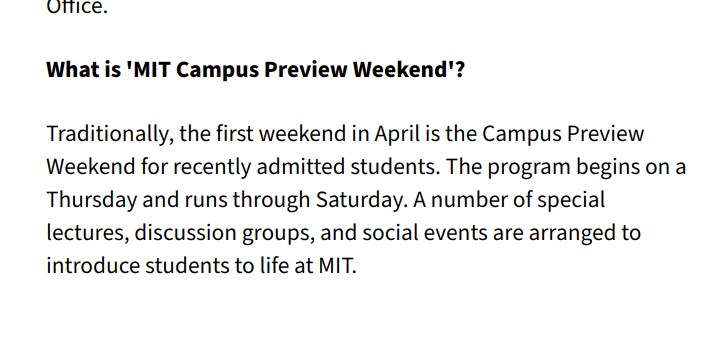
the website design is actually web 2.0 now, if you check it out
Students were a huge part in making CPW happen, something we didn’t see as much before it opened to all prefrosh. I would guess that, of the nearly 200 events CPW had each year, around three-quarters were run by students. But not only that, hundreds of student volunteers helped with registration, airport pickups, and tours. I’ve never seen19 Granted, I've only ever been to one admitted student weekend. an admitted student weekend where students handled all of these things. It’s no wonder that dean Jones said that students made the best recruiters, given the amount of contact they have with prefrosh through CPW.
Why were students so enthusiastic about doing things for CPW? Well, for one, interacting with prefrosh is a lot of fun.20 Hi 2025s! But I suspect the ongoing sentiment surrounding residences played a role in this. As I’ve discussed in the section First-years and FSILGs, residential life is such an important part of the MIT undergrad experience, and students at the time had several reasons to recruit for their living group.
And yes, the pressures to recruit frosh continued through the early 2000s. Which is interesting, given this juxtaposition between “living groups are awesome” and “feeling very neglected by the administration”. Take this 2003 Tech article, for example, which is so good that I’ll quote it wholesale:
“I really think the administration is fucking us over,” said Sven H. Chilton ’05, German House president. “First they fucked over the frats, and now they’re fucking over the dorms and cultural houses,” he said. The administration is trying to homogenize the MIT student body by not supporting dormitory and fraternity rush, he said. “A huge part of our culture is being able to find your niche,” especially within the unique living communities, Chilton said.
I really can’t overstate how important I think housing is in making CPW work. During our interview, McGann told me a story that highlighted this:
By the time I joined the office in 2001, the host-matching process was becoming an enormous project. At that point, say a week after Pi Day, we would all put ourselves into one room for a week. Ten of us times sixty hours. We’d take each individual prefrosh, and each individual host, and we’d be trying to hand match[…]
We came to think that the hand matching of students [to hosts] and trying to find the right fit was part of the special sauce of CPW. Because of the way that our housing system is set up, putting a Senior Haus person into Alphi Phi sorority, or vice-versa, would make prefrosh think, “this isn’t the place for me.” They’d get this limited sphere of thinking MIT is [a certain way], but actually it’s like this over there and not over there.
On top of that, beginning in 2002, incoming first-years could express living group preferences during the summer, giving students even more incentive to recruit. This scaled with event submissions. Admissions Officer Guerra noted that there were “more events on campus and in the residence halls this year”, and if you look at the 2002 event listing, a large proportion of the events are from dorms or FSILGs.
Two really interesting columns in the Tech, written by prefrosh, give us a glimpse of what CPW was like in 2002 and 2003. A pair of prefrosh praised the variety of activities, compared to “the few allowed by preview weekends of many other colleges.” The 2003 CPW agenda was said to fill up 25 pages of the handbook. I really wish I could look at it, but I couldn’t find the 2003 event listing anywhere. We do know, based on the article and the pictures, that there was at least liquid nitrogen ice cream.
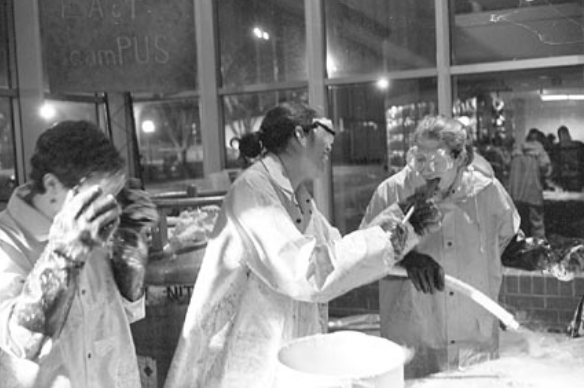
ln2 ice cream! classic event. from the tech
I also didn’t know where to fit this in, but here’s an funny column called “How to Care for Your Prefrosh”.
Shenanigans
Caltech, Tetris, and other hacks
If there’s a great time to put up a hack,21 Hack here referring to a clever, amusing prank or practical joke. it must be CPW. Not only do a thousand prefrosh get to see the work, but it might even bring them closer to attending MIT. Indeed, lots and lots of hacks have been put up during CPW, ranging from small decorations to some of MIT’s most famous ones. For example, banners would just roll out of the ceiling during certain large events, either promoting MIT or pulling down Harvard.
Other fun hacks include zombie chainsaws, an upside-down lounge stuck on a Media Lab ceiling, a desk on top of Building 1, a beautiful Lobby 7 circus, and a Dalek on Stata.
Maybe you’ve seen Ankita’s post about the Bombers’ annual Dance ‘Til You Drop, and how they put up a hack each year to announce it. I’m not sure how the scheduling of DTYD works, but sometimes the hack coincided with CPW, at least in 2012 and in 2015.
CPW was also the setting of a famous Caltech vs. MIT saga. In 2005, several Caltech students went to MIT during CPW to pull off what they called “pranks”. They handed off shirts which had “MIT” on the front, and “because not everyone can go to Caltech” on the back. They put out inflatable palm trees in well-known hacking spots, and covered the “Massachusetts” in Building 7 with “That Other”. Then MIT hackers replaced it with “The Only”. They shortly put up a Caltech vs. MIT website to “keep score”, although the website no longer exists. Still an amusing read though.
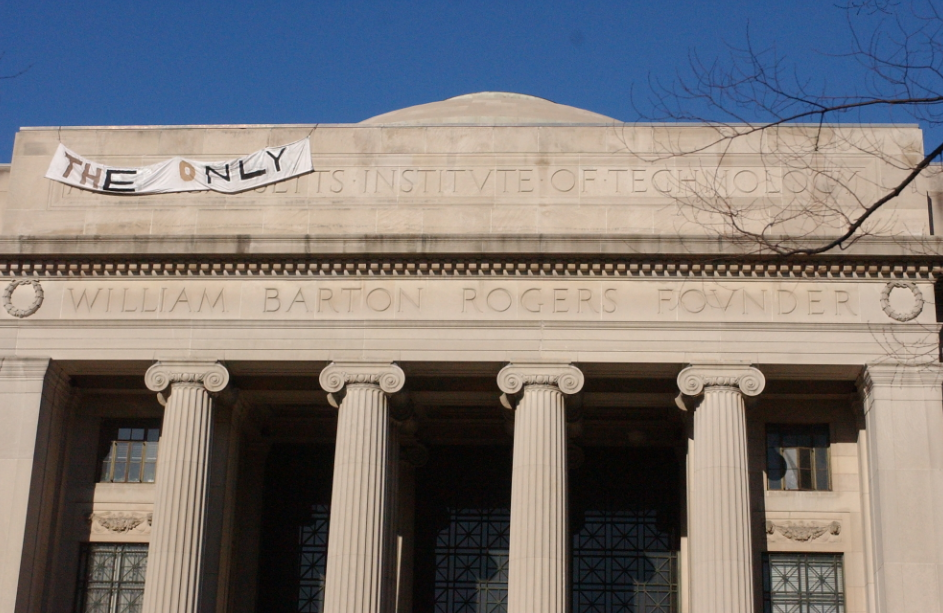
from the ihtfp hack gallery
Then in 2006 was the Caltech cannon hack. There’s a nice long write-up about it that you can read, and a column about it a year later. A bunch of people in bathing suits posed with the cannon. Then Caltech retrieved the cannon, and put up their own website documenting it. There’s lots of cool details about this that you can read about, like this column.
Apart from the impressive effort of transportation this was, another thing that impressed me was this huge Brass Rat22 The name for the MIT class ring. wrapped around the cannon. It was, apparently, made of aluminium, gold-plated, and involved machine work and alumni donations.
In 2011, a model of the cannon went up on the ledge below the Dome. In 2014, Caltech undergrads distributed several mugs during CPW, that looked like normal MIT mugs, but when heated, spelled out “Caltech”. Then in Caltech’s preview weekend, there was a giant, MIT-style admissions tube atop their admissions office.
The famous Tetris hack also happened during CPW! The idea of playing Tetris on the Green Building has been around since at least 2004, probably even before that. But it was in 2012 that hackers accomplished the “holy grail of hacks”. The LED panel was already installed in the Green Building since at least the September before, though. It was reused in 2014 to play 2048, again during CPW. Anyway, it’s really pretty, so here’s some pictures.
The weather machine
One of the famed parts of CPW is the so-called CPW weather machine. The weather around CPW has been part of the cultural consciousness since at least 2001. That year, the Tech’s weather forecast for CPW said that prefrosh would be introduced to “typical Boston weather, and not be fooled by yesterday’s beautiful weather.”
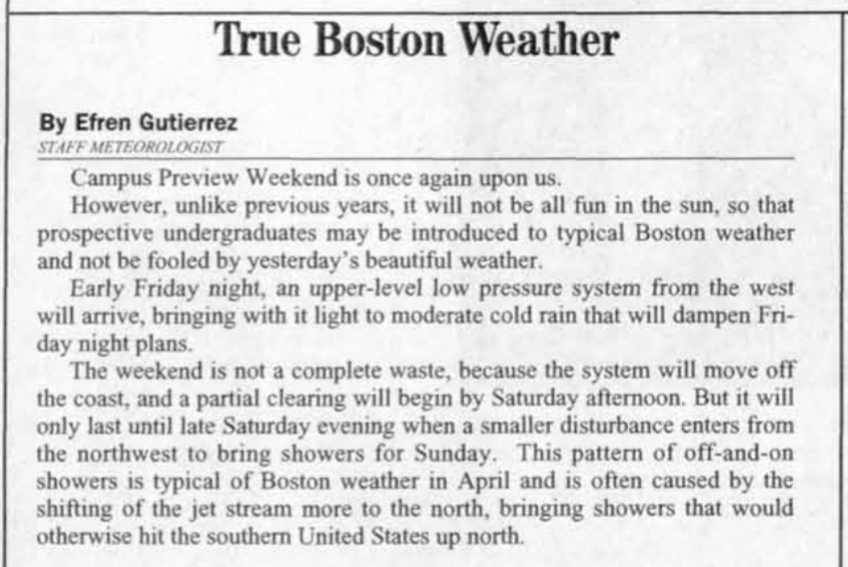
from the tech
The earliest mention I could find of the weather machine is in 2003, where it’s described as MIT’s weather-changing machine. The article has a quote from a student saying the machine was broken, but that CPW organizers were hoping that it’ll “be fixed before the end of the weekend.” Well, it definitely was fixed by 2005, with beautiful pictures in the Tech of immaculate spring weather.
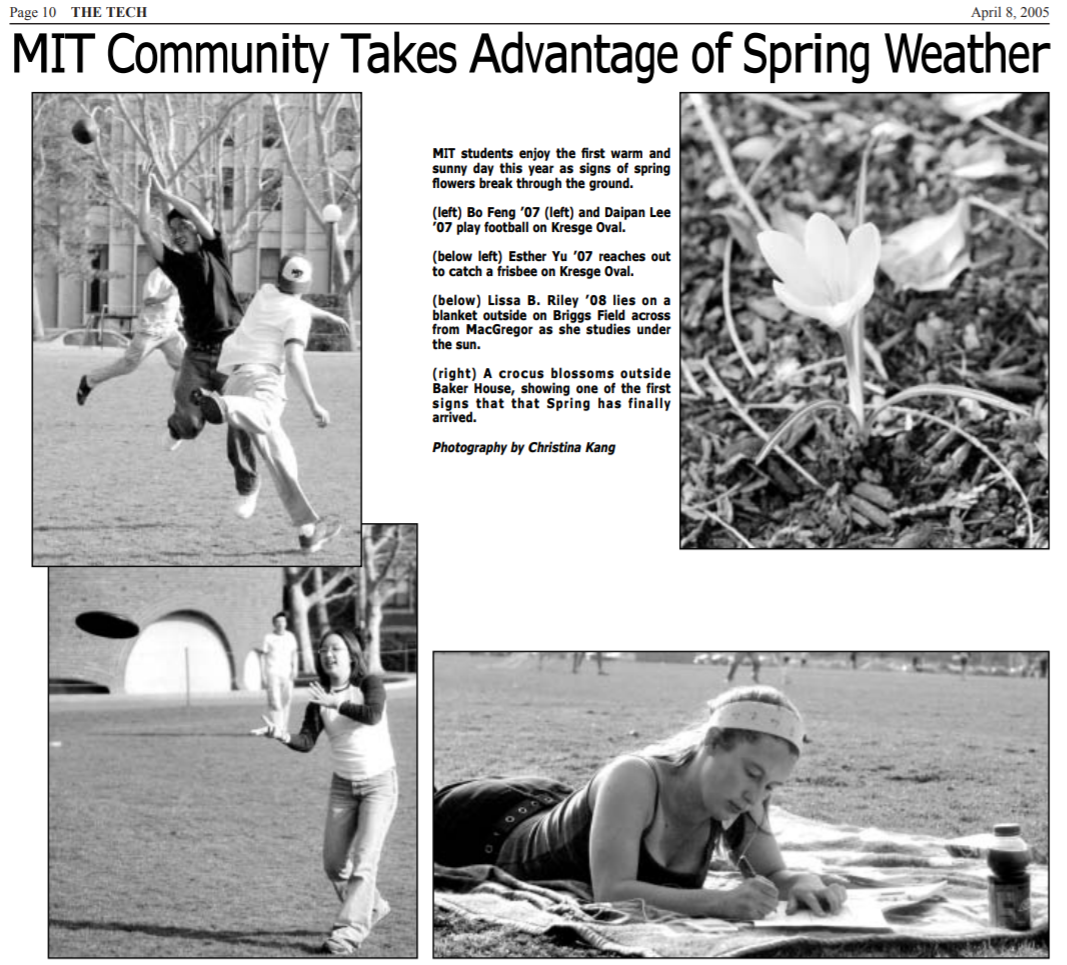
from the tech
Since then, the weather machine would appear from time to time in the Tech. In 2007, McGann was quoted saying that they’ll get the CPW weather machine to clear up the bad weather at the start of the weekend. Then 2009 had awesome weather, and McGann was quoted saying that “The CPW weather machine is back!” The phrase is definitely still around, being recorded in the Tech as recently as 2019.
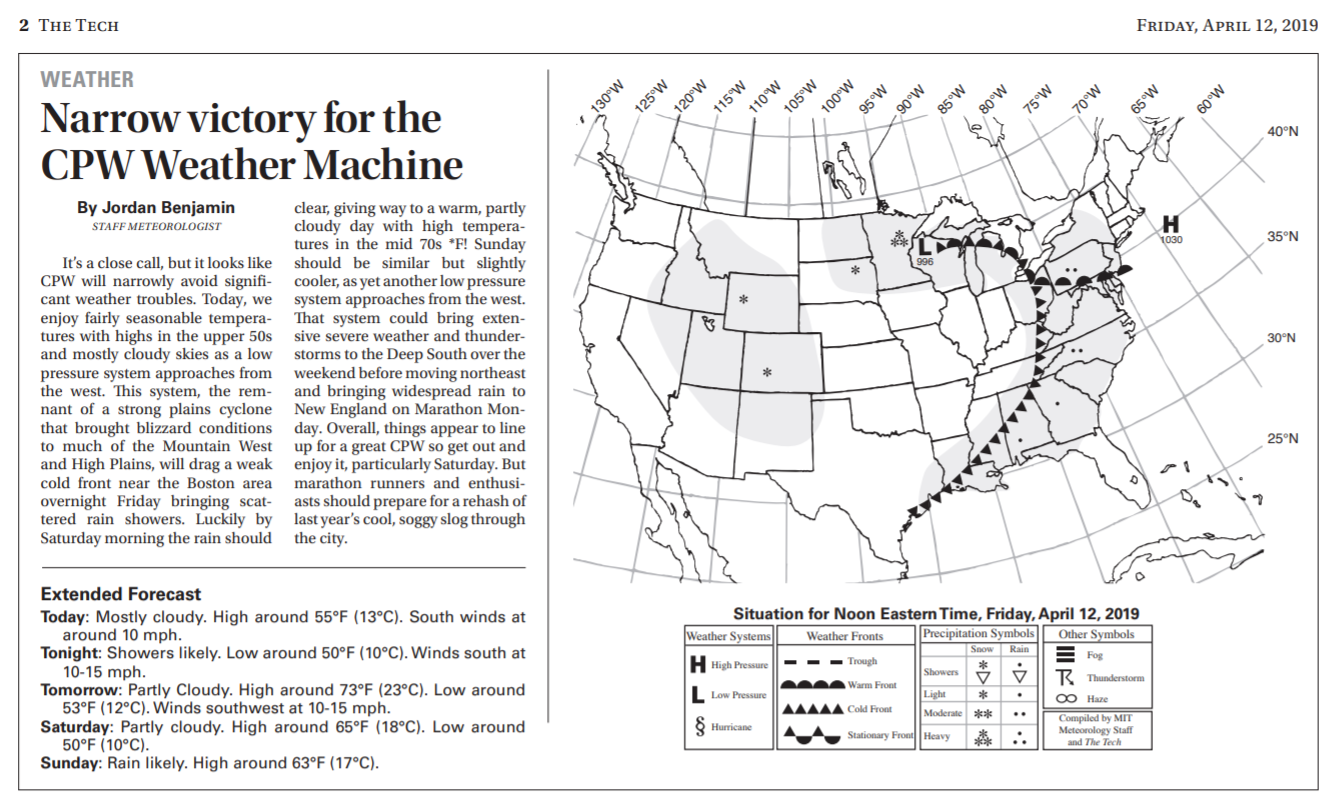
from the tech
Anyway, here’s the part that prompted this whole blog post in the first place: what the weather was like in every single CPW from 1984 to 2019. Doing research for this was pretty fun. Digging for all of the dates was more difficult than expected, because before 1999, CPW ranged from being Friday to Sunday or Thursday to Saturday or Sunday to Tuesday. I also had no idea what the dates were for 1986, 1993, and 1994, since it wasn’t anywhere I looked, so I just made a guess. Then, I needed a source for the weather. This was the easy part; it turns out that you can just buy historical weather data in bulk.
Here’s the chart itself, larger version here. Each block is thick if it’s raining and thin if it isn’t, and blocks are also colored by temperature. The scale’s in Celsius, but you can probably convert to Fahrenheit, I dunno I don’t use Fahrenheit. You can also mouseover individual blocks to see data for that hour.
This chart is now actual, scientific proof that the weather machine doesn’t exist. Observe how it’s raining about one-fifth of the time. And when it’s not raining, it tends to be pretty cold, usually between 0° or 8°. All-in-all, pretty disappointing, expected the machine to be better.
More discussion points
One of the things that’s changed about CPW since our last story in 2004 was how many events there were, and how many events each residence has. In 2004, there were 196 events, 53 from FSILGs, and presumably some proportion of which are from dormitories. There’d be “over 250 events” by 2005, and by my count, 430 events in 2006, 216 of which were from FSILGs or dorms.
A 2006 interview in the Tech addressed this, with the UA orientation committee chair at the time saying:
TT: There seems to be a trend where people come to CPW and do what would normally be Orientation activities.
AS: That actually is mentioned in the report. We do not make any policy recommendations concerning that. […] We certainly don’t want to pose any additional restrictions on CPW; we think it’s managed very well. […] It may be that people are not as satisfied with the amount of time they have during Residence Exploration. People are going to tell their prefrosh that they should go and look around at dormitories. In some respects, people should really be considering MIT as a whole, as whether you want to attend MIT or not. Getting a good feel of the dormitories can tell you a lot about MIT but if CPW becomes more import to REX than REX itself, then I think this does become a problem in the long term.
This trend, of course, continued. In 2007, by my count, there were about 600 events, 274 from living groups. Admissions started capping the number of dormitory-related events since 2012, which probably kept the event count stable since then. I couldn’t really find good numbers for any of the years in between, but by my count, 2016 also had around 600 events, around 200 from FSILGs and another 200 from dorms.
In 2011, there was a bit of a discussion about shortening REX. For context, REX is the residential exploration that happens during orientation week in the fall. It’s similar to CPW in that a bunch of living groups host events for first-years. The linked article discussed shortening REX from three days to one, out of concern for frosh being “worn out by the time classes begin.” This, of course, got some backlash from several people, and the decision was reversed.
Another interesting point of discussion, that honestly I’m so tired I’m not going to look into, was how Maseeh conducted its CPWs. Maseeh opened in the fall of 2011, and questions were raised about how it’d go about CPW 2012. I think it’s particularly relevant given the recent opening of West Garage, official name New Vassar.
CPW is dead, long live CPW
That’s it. That’s it, I’m done, I’m sick of writing this blog post. Thank goodness that I’m writing the last section.23 Okay, I'm not really done, because I'll have to format this post and then add the pictures. I also haven't made the graphs yet.
Given this post’s title “The rise and fall of CPW”, you’d expect that I’d spend some amount of time talking about this supposed “fall”. After all, the entire post leading up to this point was seven thousand words describing its rise, right? So yes. This is the part where I talk about how CPW didn’t happen in 2020, and how it will, hopefully, rise again in 2022.
In March 2020, due to concerns about COVID-19, students were kicked out of campus. Obviously, this meant that CPW couldn’t happen. So we recreated it online, called it CP✱, and did it anyway. There was haiku and Borderline art and a reading of My Immortal. Despite being virtual, CP✱ still had around 400 events and around 1200 “attendees”, which I think was actually a boost in attendance.
CPW was once again canceled this year, and we had another year of CP✱. Snively did some cross-stitching and Alan suffered by walking a marathon. It’s hard to quantify, but I think engagement actually went down this year? I think there were only around 300 events, and the CP✱ Discord server definitely felt way less active than last year’s. When I reached out to some friends, they speculated that Zoom fatigue might be a reason, and honestly, mood. So that’s it. That’s the “fall” of CPW.
I’ve never actually been to a CPW myself. I didn’t go to my year’s CPW, in 2019, because I was an international student who couldn’t afford the round trip flight. Then, of course, there wasn’t really a CPW in 2020 or 2021. In the process of doing research for this post, I found myself reading articles and looking at pictures of recent CPWs, already knowing what I’d see. Hundreds of prefrosh across hundreds of events. Wild photographs of liquid nitrogen ice cream, packed activity midways, dozens of performances. Interviews of prefrosh saying how awesome CPW is, how there are so many events, how it’s so overwhelming, how it’s all so exciting.
Honestly, it kinda made me sad. I wanted this so bad, you know? I thought it wouldn’t be too bad if I didn’t get a CPW in 2019, because I’d be doing CPW in 2020, “from the other side”, so to speak. But that didn’t happen. And it didn’t happen again.
Maybe that’s the reason I was so interested in learning what CPW was like. Through the dozens of hours of research for this post, maybe my motivation was wanting to live CPW vicariously through reports and photos. And it seems like such an awesome, amazing weekend. At once, I feel sad that I still haven’t experienced it, angry that it’s been taken away from me, excited for it to happen next year, and curious how we’ll pull it off when more than half the undergrads haven’t been to a CPW.
I am so, so ready for CPW 2022.
- I have read this column twice and I still don't get it. back to text ↑
- Per the 1986 Report, 1059 out of 1854. back to text ↑
- See this issue of the Tech: 123 enrolled, out of 165 attendees. back to text ↑
- Incidentally, the same column mentions the recommendation of a committee that parties be shut down at 1 AM, which I think became an Institute-wide event policy in the 90s. back to text ↑
- See this Tech issue; on the bottom of the second column in the top article. back to text ↑
- See this from 1994 and this from 1995. back to text ↑
- See this from 1993 and the yield among minorities this from 1995 back to text ↑
- Fraternities, Sororities, and Independent Living Groups, the catch-all term for living groups that are neither dormitories nor off-campus housing. Articles at the time used ILGs as a catch-all term for all of them, but today we use FSILGs. back to text ↑
- To rush is to recruit. Rush also refers to the period of time in which FSILGs generally recruit people, the biggest rush period being orientation week. back to text ↑
- See this article. For reference, the 2024s had a 70%ish yield, given that 1457 were admitted and there are 1073 first-years. back to text ↑
- The Lecture Series Committee, which has nothing to do with lectures, series, or committees, and instead is a club that shows movies. back to text ↑
- The Interfraternity Council, which is, well, a council of the fraternities of MIT. back to text ↑
- Residence and Orientation Week. back to text ↑
- Hat tip to McGann for pointing this out to me during our interview. I'm basically building upon the story he told me. back to text ↑
- Fiji is the nickname for Phi Gamma Delta, a former MIT fraternity. back to text ↑
- Surprising primarily because it's so rare for the faculty to weigh in on student life back to text ↑
- Oh no, will this be a sequel post? Oh please no. back to text ↑
- A nod to the cry I Hate This Fucking Place, ILTFP stands for I Love This Fucking Place. back to text ↑
- Granted, I've only ever been to one admitted student weekend. back to text ↑
- Hi 2025s! back to text ↑
- Hack here referring to a clever, amusing prank or practical joke. back to text ↑
- The name for the MIT class ring. back to text ↑
- Okay, I'm not really done, because I'll have to format this post and then add the pictures. I also haven't made the graphs yet. back to text ↑

